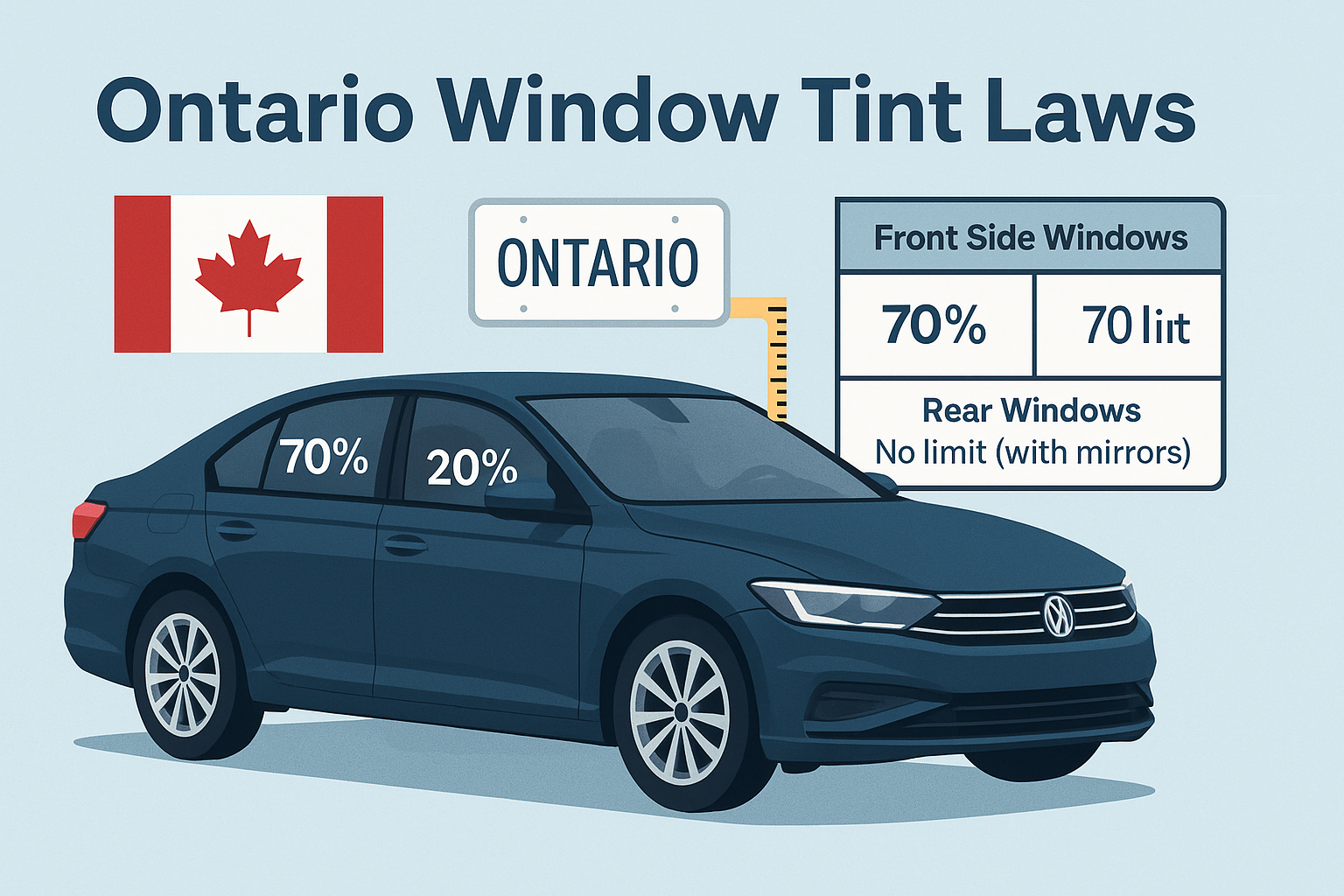Window tinting can make your car cooler—literally and visually. It blocks heat, gives you privacy, and protects your interior. But before you go dark on your windows, you need to know one thing:
Every U.S. state has different tint laws.
And if your tint is too dark, you could face fines, failed inspections, or even be ordered to remove it.
Let’s break it all down by state: front windows, back windows, windshields, and more.
What Is VLT?
VLT stands for Visible Light Transmission. It measures how much light passes through your tinted window.
- 70% VLT = Very light tint
- 35% VLT = Medium tint
- 5% VLT = Very dark (limo tint)
Lower VLT = darker tint.
Most states set legal limits based on VLT percentages.
Why Window Tint Laws Exist
It’s all about safety.
Too-dark tints make it hard for police to see inside a vehicle. They can also reduce visibility for drivers at night.
That’s why states regulate window tint percentages. It’s not about killing your style—it’s about making sure you and others stay safe.
How to Read State Tint Laws
Each state usually sets limits for:
- Windshield
- Front side windows
- Back side windows
- Rear window
Some states allow darker tint on back windows. Others require the same percentage all around.
Let’s look at the rules state by state.
U.S. Window Tint Laws by State (2025)
Here’s a breakdown of legal VLT percentages for front side windows, which are most commonly regulated.
| State | Front Side VLT% | Windshield Tint | Rear Side/Back Window |
|---|---|---|---|
| Alabama | 32% | Top 6 inches | 32% |
| Alaska | 70% | Top 5 inches | 40% |
| Arizona | 33% | Top AS-1 line | Any |
| Arkansas | 25% | Top 5 inches | 10% |
| California | 70% | Top 4 inches | Any |
| Colorado | 27% | Top 4 inches | 27% |
| Connecticut | 35% | Top AS-1 line | 35% |
| Delaware | 70% | None | Any |
| Florida | 28% | Top AS-1 line | 15% |
| Georgia | 32% | Top 6 inches | 32% |
| Hawaii | 35% | Top 4 inches | 35% |
| Idaho | 35% | Top AS-1 line | 20% |
| Illinois | 35% | Top 6 inches | 35% |
| Indiana | 30% | Top AS-1 line | 30% |
| Iowa | 70% | None | Any |
| Kansas | 35% | Top AS-1 line | 35% |
| Kentucky | 35% | Top AS-1 line | 18% |
| Louisiana | 40% | Top 5 inches | 25% |
| Maine | 35% | 4 inches | Any |
| Maryland | 35% | Top 5 inches | 35% |
| Massachusetts | 35% | Top 6 inches | 35% |
| Michigan | No tint allowed | 4-inch strip only | Any |
| Minnesota | 50% | None | 50% |
| Mississippi | 28% | Top AS-1 line | 15% |
| Missouri | 35% | Top AS-1 line | Any |
| Montana | 24% | Top AS-1 line | 14% |
| Nebraska | 35% | Top 5 inches | 20% |
| Nevada | 35% | Top AS-1 line | Any |
| New Hampshire | Not allowed | No tint allowed | 35% (rear only) |
| New Jersey | Not allowed | No tint on front windows | Any on rear windows |
| New Mexico | 20% | Top 5 inches | 20% |
| New York | 70% | No more than 6 inches | 70% |
| North Carolina | 35% | Top AS-1 line | 35% |
| North Dakota | 50% | Top 5 inches | Any |
| Ohio | 50% | Top AS-1 line | Any |
| Oklahoma | 25% | Top 5 inches | 25% |
| Oregon | 35% | Top 6 inches | 35% |
| Pennsylvania | 70% | No lower than 70% | 70% |
| Rhode Island | 70% | Top 6 inches | 70% |
| South Carolina | 27% | Top AS-1 line | 27% |
| South Dakota | 35% | Top AS-1 line | 20% |
| Tennessee | 35% | Top AS-1 line | 35% |
| Texas | 25% | Top 5 inches | Any |
| Utah | 43% | Top AS-1 line | Any |
| Vermont | Not allowed | No front window tint | 32% on rear windows only |
| Virginia | 50% | Top AS-1 line | 35% |
| Washington | 24% | Top 6 inches | 24% |
| West Virginia | 35% | Top 5 inches | 35% |
| Wisconsin | 50% | Top AS-1 line | 35% |
| Wyoming | 28% | Top 5 inches | 28% |
What’s the Most Common Legal Tint?
Most states stick to 35% VLT for the front windows.
A few go lighter—like New York (70%) or Minnesota (50%).
A few go darker—like Montana (24%) or Texas (25%).
What States Are Strictest About Tint?
- New Jersey and New Hampshire don’t allow any tint on front side windows.
- New York and Delaware require 70%—that’s barely tinted at all.
- Michigan only allows a 4-inch strip at the top of front windows.
If you live in these states, go easy on the tint.
Medical Exemptions
Many states allow medical exemptions for those with conditions like:
- Skin cancer
- Lupus
- Light sensitivity
You’ll need a doctor’s note and to register the exemption with your DMV.
Not all states offer this—check with your local agency.
Can You Be Pulled Over for Tint?
Yes, absolutely.
If an officer suspects your tint is illegal, they can stop you and test it with a tint meter.
If your windows are too dark, you could get:
- A fine (anywhere from $25 to $500)
- A “fix-it” ticket
- Rejection from a state inspection
Pro Tips Before You Tint
- Check your state laws before tinting.
- Ask your tint installer if their film is certified and legal in your state.
- Save documentation and ask for a compliance sticker if your state requires one.
- Avoid mirror or reflective tint unless it’s legal in your area.
- Don’t assume what’s legal in one state is legal in another.
Summary
Getting your car windows tinted is great for comfort, privacy, and looks—but it comes with rules.
Every U.S. state sets its own legal tint percentage, mostly based on VLT (Visible Light Transmission).
Most allow 35% on front windows, but some require 70%, and others allow 25% or less.
Check your local laws, tint responsibly, and avoid unnecessary tickets.
Key Takeaways
- VLT measures how much light a tint allows through.
- Tint laws differ by state—know yours before tinting.
- Fines, rejections, or removal orders can happen if you’re not compliant.
- Always get tint installed by a licensed, reputable shop.
Frequently Asked Questions (FAQs)
❓ What is the darkest legal tint in the U.S.?
It depends on the state. Montana allows 24% VLT, Texas allows 25%, while California requires a light 70% on front windows. Check your local laws.
❓ Can you legally tint your front windshield?
Usually not. Most states only allow a small tinted strip (around 4–6 inches) at the top of the windshield. Some states don’t allow any tint on the windshield at all.
❓ Will my car fail inspection if my tint is too dark?
Yes, in many states your car can fail a safety or emissions inspection if the tint doesn’t meet legal VLT standards. You’ll likely need to remove it to pass.
❓ How do police test window tint?
Officers use a portable tint meter to check VLT on the spot. If your tint is darker than allowed, you could get fined or ticketed.
❓ Are window tint laws the same for front and rear windows?
Not always. Many states allow darker tint on rear side windows and rear windshields, but keep front side windows more restricted. Always check both.
❓ Is reflective or mirrored tint legal?
Not in most states. Reflective or mirrored tint is banned in many areas because it can reflect too much light and impair visibility for other drivers.
❓ Can I get a medical exemption for darker tint?
Yes, many states allow exemptions for conditions like light sensitivity or skin disorders. You’ll need a doctor’s certificate and approval from the DMV.
❓ What happens if I move states with my tinted car?
If your tint is legal in one state but illegal in another, you may be required to remove or adjust it to pass inspection in your new state. Laws don’t transfer.
❓ How much does legal window tint cost?
It depends on the film quality and the number of windows. Expect to pay anywhere from $100 to $500 for professional, legal tint.
🏁 Final Thoughts
Tinting your car windows offers more than just a sleek look—it adds comfort, protects against UV rays, and gives privacy. But that only works if you’re within the law.
U.S. window tint laws are not one-size-fits-all. From California’s light tints to Texas’s darker allowances, each state sets its own rules. Before you tint, always check your state’s legal limits.
And remember—legal doesn’t mean boring. You can still get a stylish tint that keeps you cool, looks clean, and passes inspection.
Stay informed. Tint smart. And keep it legal.

